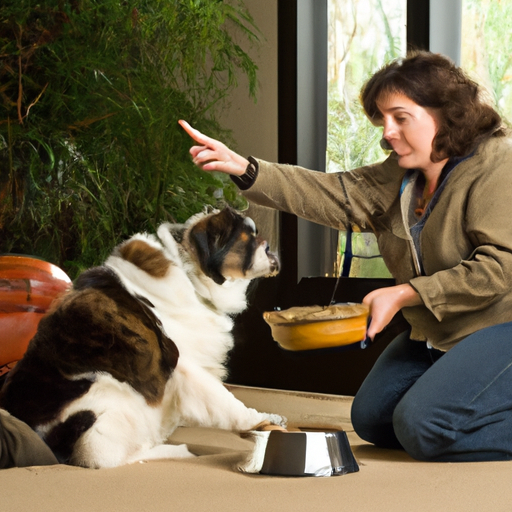Understanding Food Aggression
First thing’s first. You need to understand what food aggression is. Is your dog growling, snarling, or snapping when eating? This is a clear sign of food aggression, an instinctual response rooted in the desire to protect what they consider valuable. It’s not a flattering trait, but it’s natural. However, when it’s directed towards your cat, it can be a serious problem.
Recognizing the Signs of Food Aggression
Food aggression can be categorized into three levels: mild, moderate, and severe.
- Mild: The dog growls and snarls but doesn’t snap.
- Moderate: The dog snaps or lunges when approached.
- Severe: The dog bites to protect their food.
Understanding the level of your dog’s food aggression will help you to plan your intervention more effectively.
Implementing Training Techniques
Training your dog to behave around cats and food is crucial. Here are a few techniques:
- Desensitization: Gradually get your dog used to the cat being around during meal times. Start by having the cat in the same room but at a distance, and gradually decrease that distance over time.
- Counter-conditioning: Teach your dog that the cat’s presence during meals is a positive thing. Reward your dog for calm behavior when the cat is near.
- Feed separately: To reduce tension, try feeding your dog and cat in separate rooms.
- Professional help: If your dog’s food aggression is severe, consider hiring a professional dog trainer or behaviorist.
Creating a Safe Environment
Creating a safe and secure environment for both your pets is paramount. This includes:
- Ensuring that both pets have their own eating and drinking bowls.
- Providing separate feeding areas.
- Making sure that each pet has its own space for resting and playing.
| Safety Measure | Implementation |
|---|---|
| Separate Bowls | Dog bowl and cat bowl in different locations |
| Separate Feeding Areas | Feed pets in different rooms |
| Separate Spaces | Separate dog bed and cat bed |
Managing Interactions
Try to manage the interactions between your dog and cat as much as possible, especially during meal times. Keep a close eye on their body language and separate them if tension arises. Also, ensure they both get plenty of exercise, as a tired dog is typically a well-behaved dog.
FAQs
Q: How long will it take for my dog’s food aggression to improve?
A: It depends on the severity of the aggression and the dog itself. Consistency is key in training.
Q: Can I punish my dog for being aggressive?
A: Punishing your dog may escalate the aggression. Positive reinforcement is a better approach.
Q: Do certain breeds of dogs have a higher tendency of food aggression?
A: Food aggression can occur in any breed. It’s not breed-specific.
Q: Can food aggression be completely cured?
A: With consistent training and management, food aggression can definitely be improved, if not completely cured.
Remember, every dog is unique. What works for one may not work for another. Always consult with a professional if you’re unsure about handling food aggression.



